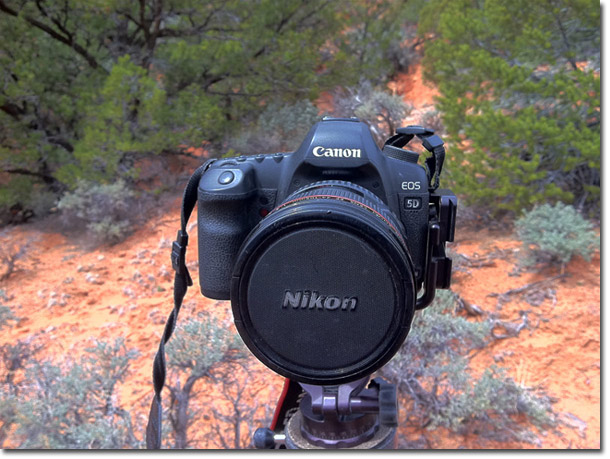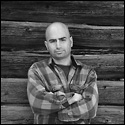The Essential Landscape: |
Sometimes receiving the best answer is about knowing to ask the right question. If there is one question I get more often than any other, it is "What camera do you use?" The easiest answer would be, of course, to provide the make and model of what happens to be the camera I own right now. But as an educator, I realize that while the inquirer may walk away thinking they received a piece of useful information, in fact the opposite is true. Not only is this information by itself entirely useless, it may be detrimental to their progress if not accompanied by more practical advice.
The reason for the question is quite obvious. Camera manufacturers spend their marketing dollars trying to convince potential buyers that an extra megapixel, frame per second, nifty acronym, or engraved lettering is the only thing standing in their way to producing great images; online discussion forums are dominated by overnight experts waging gear wars and spewing reviews; and magazine articles speculate on whether Ansel Adams would have made the leap from 18 megapixels to 21. But one simple and obvious fact is drowned in the melee: great photography is ultimately not about cameras; great photography is about great photographs.
When you think of great photographs instead of great gear, what comes to mind? Ansel Adams's impressive western landscapes? Henri Cartier-Bresson's perfectly timed street work? Galen Rowell's adventure photography? Robert Capa's powerful war images? Pick your favorite classic and chances are even your entry-level DSLR will score higher on the spec sheet than the gear they used to make some of the most striking and memorable images ever made.
In order to progress as a photographer, it is worthwhile to put things in their proper perspective (literally and figuratively). Rather than asking, "What camera should I buy?" ask instead, "How can I make great images?" With this simple shift in priorities comes a sea change in perception. Rather than thinking in objective technical terms of numbers, acronyms and meaningless model numbers, you are now ready to consider subjective things such as light, composition, emotion, timing and aesthetics – the things that actually do have the potential to take your images from (technically) "good" to "great."

There is no doubt about it: a camera is one of the most amazing and inspiring tools ever invented. If you remember the experience of holding your first "real" camera for the first time, as I do, you no doubt recall the sense of fascination and magic and the overwhelming urge to run out and make great images. And perhaps one of the greatest spoilers for new photographers is visiting a photo forum for the first time to find their new prized possession maligned by "experts" whose sole qualification is an obsession with technical minutia. If you are new to the world of photography, here's a piece of practical wisdom: the value of any photographic advice should always be examined in the context of the portfolio of the person offering it. Find their web site (if they have one), review their work for creativity, meaning and emotional appeal, and ask yourself how well their wisdom served them in their own pursuits. And when you discover work that inspires you, don't stop at finding out what camera was used to make it. Ask the photographer if the same image could have been made with equal success using other brands of equipment. It is doubtful that the answer will be anything other than a resounding "yes."
Undoubtedly, some features of some cameras may come into play in specific applications. Still, these are of secondary importance to the photographer's creativity and vision, and a far second at that.
Why, then, do some photographers vehemently favor one brand over another? For the most part, they can't help it. In his book "The Naked Brain", Dr. Richard Restak discusses the neuroscience behind brand loyalty and describes the famous Pepsi vs. Coke test. When subjects are not aware of the brand, they consistently favor Pepsi as the better tasting cola. When the brands are known, though, they overwhelmingly prefer Coke. The truth is that the brain associates certain traits with certain brands, based on the promotion and marketing associated with it. In reality, however, these perceived traits might be entirely untrue or even opposed to common sense.
Speaking from my own experience, I have seen the same attitude in photographers who tend to praise any work made with, say, Large Format equipment, as opposed to more common formats. Just tell a photographer that an image they see on the web (where the difference is impossible to tell) was made with a 4x5 or 8x10 camera and they immediately think highly of it, no matter how poor the composition, light, or processing. On several occasions when visitors to my gallery asked about the camera I used, I explained that the narrower prints are likely from 35mm digital, while the more "squat" ones are generally from 4x5 Large Format. In almost every case these same people will then wander to one specific and popular image, printed to 20"x24", and praise it for the obvious qualities of the 4x5 format. It just so happens that the image in question was cropped from a 35mm digital capture.
To answer someone asking about your camera with just the brand and model is doing them a great disservice. The path to a great image does not end with "I paid $X for a brand/model, pointed it at a pretty scene and pushed the button." There is creativity and subject matter and composition and visualization and field technique and light and processing and any number of other factors that are far more important than the literal answer to the question. If someone ever asks you what camera you use, do the right thing and go beyond the simple answer. Help them instead to ask the right question and to find the correct balance of priorities.
A great photographer is a person who makes great photographs, not necessarily a person who owns a great camera.
Comments on NPN nature photography articles? Send them to the editor. NPN members may also log in and leave their comments below.
 Guy Tal is a professional photographer and author residing in the state of Utah, in the heart of a unique and scenic desert region known as the Colorado Plateau. Guy teaches and writes about the artistic and creative aspects of photography and guides private workshops and individuals seeking the beauty and solitude of the canyon country. More of his works and writings can be found on his web site and blog at guytal.com. You may also follow Guy on Facebook or Twitter.
Guy Tal is a professional photographer and author residing in the state of Utah, in the heart of a unique and scenic desert region known as the Colorado Plateau. Guy teaches and writes about the artistic and creative aspects of photography and guides private workshops and individuals seeking the beauty and solitude of the canyon country. More of his works and writings can be found on his web site and blog at guytal.com. You may also follow Guy on Facebook or Twitter.